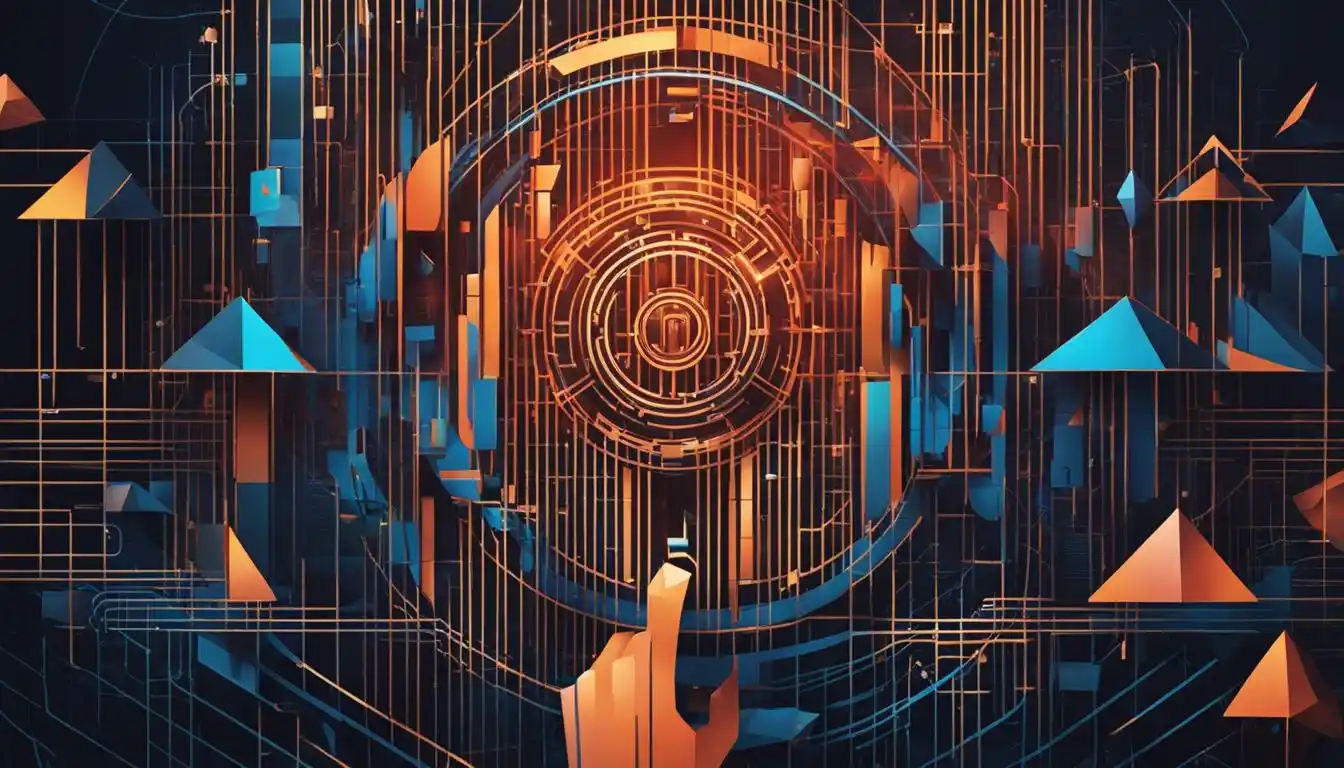
If you're new to the world of cryptography, you may have heard the term "Schnorr signature" being thrown around. But what exactly is it? In simple terms, Schnorr signatures are a type of digital signature scheme that provide enhanced security and efficiency compared to other existing schemes like RSA and ECDSA.
In this beginner's guide, we will provide an overview of Schnorr signatures, exploring their importance, how they work, and why they are significant in the field of cryptography. Whether you're a software developer, a security enthusiast, or just someone curious about digital signatures, this guide will provide you with the foundation you need to understand Schnorr signatures.
An abstract representation of the concept of digital security through the use of geometric shapes and colors. The shape in the center should resemble a lock, with various lines and shapes surrounding it to symbolize layers of protection. A hand reaching out to touch the lock could represent the use of Schnorr signature technology to verify transactions.
Key Takeaways
- Schnorr signatures are a type of digital signature scheme that provide enhanced security and efficiency
- Schnorr signatures are important in the field of cryptography due to their many advantages over existing schemes like RSA and ECDSA
- This beginner's guide will provide an overview of Schnorr signatures, including their key features, how they work, and their potential applications
Understanding Cryptographic Signatures
Before diving into Schnorr signatures, it's essential to have a basic understanding of cryptographic signatures. Cryptographic signatures are virtual fingerprints for digital messages. They verify that the message was not tampered with and was, in fact, sent by the claimed sender.
Cryptographic signatures are formed by creating a hash of the message using a cryptographic hash function. The hash is then encrypted using the sender's private key, forming the signature. The receiver can verify the message's authenticity by decrypting the signature with the sender's public key and comparing it to the hash of the original message. If they match, the message is authentic.
Cryptographic signatures are crucial in establishing trust in digital transactions, communications, and identities. They ensure the integrity, authenticity, and non-repudiation of messages, making them resistant to forgery and tampering.
Types of Cryptographic Signatures
There are different types of cryptographic signature schemes, such as RSA and ECDSA, each with its particular strengths and weaknesses. They differ in their underlying mathematics, the length of their keys, the size of the signature, and their resistance to specific types of attacks.
RSA is one of the most widely-used signature schemes, named after the surnames of its inventors Ron Rivest, Adi Shamir, and Leonard Adleman. RSA uses the difficulty of factoring large numbers to ensure the security of its public-private key pair. However, RSA signatures can be large, making them inefficient for use in some applications.
ECDSA is another widely-used signature scheme, based on elliptic curve cryptography. It is more efficient than RSA and produces smaller signatures. However, ECDSA is susceptible to certain types of attacks, such as side-channel attacks.
Schnorr signatures are a more efficient and secure signature scheme that could potentially replace RSA and ECDSA in the future. They have smaller signature sizes, faster verification times, and are resistant to certain types of attacks.
"Cryptographic signatures are crucial in establishing trust in digital transactions, communications, and identities."
The Need for Schnorr Signatures
As mentioned in the previous section, existing signature schemes like RSA and ECDSA have limitations in terms of efficiency and security. With the increasing demand for more secure and efficient digital transactions, there is a need for new and improved signature algorithms like Schnorr signatures to address these limitations.
"Schnorr signatures offer a more efficient and secure alternative to existing signature schemes, making them ideal for various digital applications."
One of the key advantages of Schnorr signatures is their ability to enable batch validation. This means that multiple signatures can be validated all at once, reducing the computational cost of verifying signatures in large batches of transactions.
Furthermore, Schnorr signatures are resistant to certain types of attacks, such as side-channel attacks, where an attacker tries to gain information about a signature by analyzing the physical properties of the device on which the signature was created. This resistance makes Schnorr signatures particularly attractive for low-power devices, where traditional signature schemes may be vulnerable to attack.
Overall, the need for Schnorr signatures is clear. They offer a more efficient and secure alternative to existing signature schemes, making them ideal for various digital applications.
Introducing Schnorr Signatures
Now that we understand the basics of cryptographic signatures, let's dive into the world of Schnorr signatures. Introduced by Claus-Peter Schnorr in 1991, Schnorr signatures are a type of digital signature that provide superior security and efficiency when compared to other signature schemes such as RSA and ECDSA.
At their core, Schnorr signatures are based on mathematical problems involving discrete logarithms, which are notoriously difficult to solve. This makes Schnorr signatures highly resistant to attacks and ensures that signed messages remain tamper-proof. Additionally, Schnorr signatures have a smaller signature size than other schemes, making them more efficient to use in various digital applications.
One of the key advantages of Schnorr signatures is their ability to support batch verification, which allows multiple signatures to be verified simultaneously in a single round of computation. This feature significantly reduces the computational overhead of signature verification, making it faster and more efficient.
Mathematics behind Schnorr Signatures
Although the mathematical concepts behind Schnorr signatures can be complicated, a high-level understanding of the process is still possible. In brief, Schnorr signatures involve the following steps:
- Generation of a public and private key pair.
- Generation of a random number or nonce.
- Creation of a commitment to the nonce and message to be signed.
- Generation of a signature using the private key and the committed nonce.
- Verification of the signature using the public key and the committed nonce.
It's important to note that the nonce used in the signing process must be unique for each signature to prevent certain types of attacks. Schnorr signatures also support the use of multisignatures, allowing for the collaborative signing of messages by multiple parties.
Overall, the unique properties and efficient design of Schnorr signatures make them a valuable addition to the world of cryptography. By introducing Schnorr signatures, we can improve the security and efficiency of digital signatures, making them more accessible and widely used in various industries.
Key Features of Schnorr Signatures
Schnorr signatures have a range of features that make them attractive for various cryptographic applications. Here are some of the key features:
- Provable security: Schnorr signatures provide a higher level of security than many other signature schemes, as their security has been mathematically proven.
- Efficiency: Schnorr signatures are very efficient, requiring fewer computations than many other signature schemes.
- Resistant to certain types of attacks: Schnorr signatures are resistant to several types of attacks, including collision attacks and side-channel attacks.
- Batch verification: Schnorr signatures allow for batch verification, which means multiple signatures can be verified at the same time, reducing computation time and improving efficiency.
- Multisignature schemes: Schnorr signatures can be used to implement multisignature schemes, where multiple parties can sign a message, ensuring greater security and accountability.
The efficiency and provable security of Schnorr signatures make them an attractive option for various applications. However, it's crucial to note that they are not a one-size-fits-all solution, and the best signature scheme for a particular use case will depend on various factors, including the level of security required and the specific use case requirements.

Create an image of a lock and a key, with the lock representing the security and privacy features of Schnorr signatures, and the key representing the verification benefits. Show the lock as impenetrable, with no visible gaps or weaknesses, while the key should fit perfectly and effortlessly into the lock. Use contrasting colors to emphasize the differences between these two elements. Finally, add a background that signifies trust and reliability.
How Schnorr Signatures Work
Now that we've discussed the need for Schnorr signatures and their key features, it's time to dig into how they actually work.
First, let's cover the basics: a Schnorr signature consists of three algorithms: key generation, signing, and verification.
Key Generation
The first step in using Schnorr signatures is generating a public-private key pair. This is achieved by following these steps:
- Choose a random integer, d, as the private key.
- Compute the public key as P = d x G, where G is a generator point on the curve being used.
The private key must be kept secret, while the public key can be shared with others.
Signing
Once a key pair has been generated, you can use your private key to sign a message. To do this, follow these steps:
- Choose a random integer, k, and compute the point R = k x G.
- Compute the value e, which is the hash of the message being signed.
- Compute the value s as s = k - e x d (mod n), where n is the order of G.
The resulting signature is the pair (R,s).
Verification
Verification of a Schnorr signature is a straightforward process. To verify a signature, follow these steps:
- Compute the value e, which is the hash of the message being verified.
- Compute the point R' = s x G + e x P.
- If R' is equal to R, the signature is valid. Otherwise, it is invalid.
That's it! By following these simple steps, you can generate a secure signature that can be used to authenticate digital messages.
Advancements in Schnorr Signatures
Schnorr signatures have been around for over 30 years, but recent advancements have made them even more appealing for use in real-world applications. One of the most significant developments has been the introduction of multisignature schemes.
With multisignature schemes, multiple parties can sign a single message, and the resulting signature is a combination of all the individual signatures. This approach offers enhanced security for transactions, as it ensures that multiple parties must approve a transaction before it can be executed. Multisignature schemes are especially useful in scenarios where multiple individuals or organizations are involved in a transaction.
Another significant advancement is the development of threshold signatures. Threshold signatures allow a group of parties to perform a multisignature scheme where only a certain number of members of the group need to be online to create a valid signature. This approach is useful in scenarios where some members of the group may not be available to sign a message at all times, as it ensures that a valid signature can still be generated as long as the required number of members are present.
Furthermore, Schnorr signatures are being considered for use in sidechains and layer-two solutions, which can increase the scalability and speed of blockchain transactions. While these solutions are still in development, they hold great promise for the future of blockchain technology.
Comparison of Schnorr Signatures with Other Signature Schemes
| Signature Scheme | Advantages | Disadvantages |
|---|---|---|
| Schnorr Signatures | - More efficient than RSA and ECDSA - Offers enhanced security through multisignature and threshold signature schemes - Can be used in sidechains and layer-two solutions to enhance scalability and speed |
- Not as widely adopted as other signature schemes |
| ECDSA | - Widely adopted - Offers strong security |
- Can be slow for large transactions |
| RSA | - Widely adopted - Offers strong security |
- Can be slow for large transactions |
Overall, with recent advancements and potential future applications, Schnorr signatures are becoming an increasingly attractive option for enhancing security and efficiency in various industries.
Implementations and Adoption of Schnorr Signatures
The adoption of the Schnorr signature algorithm has been relatively slow due to the need for significant changes in existing cryptocurrency protocols. However, there have been recent developments in Schnorr signature technology that have led to broader adoption and integration.
One example of this is the Taproot soft fork proposal, which integrates Schnorr signatures into Bitcoin. This proposal is currently being reviewed and has garnered significant support from developers and users alike. If Taproot is adopted, it could significantly enhance the privacy, scalability, and efficiency of Bitcoin transactions.
Comparison with ECDSA
It's important to note that while Schnorr signatures have been proven to be more secure and efficient than ECDSA, the current standard for cryptographic signatures, switching to Schnorr signatures requires considerable effort and resources. Therefore, it may take some time for Schnorr signatures to become widely adopted, especially outside the Bitcoin community.
Other Adopters
Other cryptocurrencies, such as Litecoin and Groestlcoin, have already implemented Schnorr signatures, and other projects are exploring their potential integration. For example, the Grin cryptocurrency project is considering using Schnorr signatures to improve the privacy of its transactions.
Challenges in Adoption
One of the biggest obstacles to the adoption of Schnorr signatures is the need for backward compatibility with existing signature algorithms. This is especially true for systems that rely heavily on multisignatures, as changing the signature algorithm could impact the interoperability of different protocols.
Additionally, there is a lack of standardization in the implementation of Schnorr signatures, which could lead to fragmentation and hinder widespread adoption. There is ongoing work to address this issue, and it's likely that we will see more standardization in the future.
Conclusion
While the adoption of Schnorr signatures has been slow, there is growing interest and development in this area. As more projects explore the potential benefits of Schnorr signatures, and as standards become more established, we are likely to see wider adoption and integration of this powerful cryptographic tool.
Conclusion
By now, you should have a better understanding of what Schnorr signatures are and how they can enhance security and efficiency in various digital applications. These cryptographic signatures offer provable security, resistance to certain types of attacks, and more.
Recent advancements in Schnorr signature technology, such as multisignature schemes and threshold signatures, have expanded their applications and potential impact on various industries. However, their adoption in real-world scenarios still poses a challenge.
Nevertheless, with the potential benefits they offer, it's worth exploring and experimenting with Schnorr signatures. So, if you're a beginner in the field of cryptography, this guide is a great starting point for you to unlock the full potential of Schnorr signatures. Keep learning, keep experimenting, and stay ahead in the world of digital security.
FAQ
What is a Schnorr signature?
A Schnorr signature is a digital signature algorithm that provides a secure and efficient way to verify the authenticity and integrity of messages. It is based on the mathematical properties of a specific type of mathematical function known as the Schnorr group.
Why are Schnorr signatures important?
Schnorr signatures are important because they offer several advantages over traditional signature schemes. They are more efficient, provide better security guarantees, and have additional features such as multisignature support and threshold signatures.
How do cryptographic signatures work?
Cryptographic signatures work by using a combination of a private key and a signing algorithm to create a unique digital signature for a message. This signature can then be verified using a corresponding public key and a verification algorithm to ensure that the message has not been tampered with.
What are the limitations of existing signature schemes?
Existing signature schemes, such as RSA and ECDSA, have limitations in terms of efficiency, security, and flexibility. They can be susceptible to certain types of attacks and may not provide the same level of security guarantees as newer algorithms like Schnorr signatures.
How do Schnorr signatures differ from other signature schemes?
Schnorr signatures differ from other signature schemes in several ways. They have a more efficient signing and verification process, offer stronger security guarantees due to their mathematical properties, and have additional features such as support for multisignature schemes.
What are the key features of Schnorr signatures?
Some key features of Schnorr signatures include provable security, efficiency, resistance to certain types of attacks such as side-channel attacks, support for multisignature schemes, and the ability to generate non-interactive zero-knowledge proofs.
How do Schnorr signatures work?
Schnorr signatures work by using a combination of public and private keys. The private key is used to generate a unique signature for a given message, while the public key is used to verify the signature. The signature is created using a specific mathematical function known as the Schnorr group.
What advancements have been made in Schnorr signatures?
Recent advancements in Schnorr signatures include the development of multisignature schemes, which allow multiple parties to collectively sign a message, and threshold signatures, which enable secure signing using a threshold of individual signatures. These advancements have expanded the potential applications of Schnorr signatures.
How widely are Schnorr signatures implemented and adopted?
While Schnorr signatures are gaining recognition and interest within the cryptography community, their implementation and adoption in real-world scenarios are still relatively limited. Integrating Schnorr signatures into existing systems can pose challenges, but their potential benefits in terms of security and efficiency make them an area of ongoing research and development.







